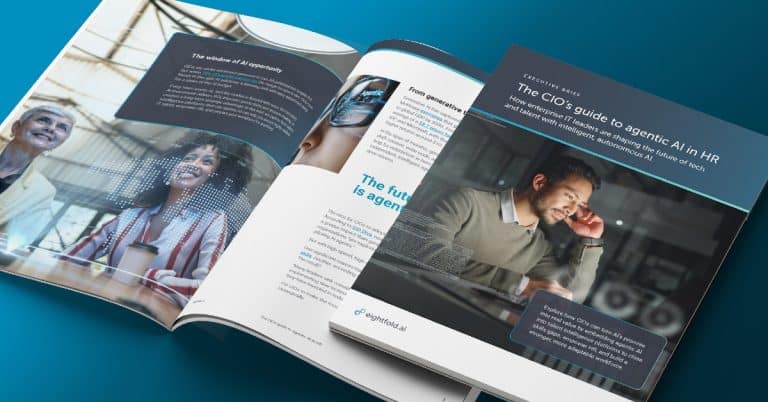
The CIO’s guide to agentic AI in HR
The CIO’s guide to agentic AI in HR
CIOs are under enormous pressure to turn AI’s potential into tangible ROI. The stakes for adopting agentic AI are high — and the margin for error is slim. It’s why CIOs and other IT leaders must invest in the right AI solutions now to drive real results in the near future.
In this executive brief, you’ll quickly learn why HR is the ideal area of your workforce to start integrating agentic AI into the tech stack. With real-time data on skills, talent intelligence combined with agentic AI quickly surfaces and moves the right talent along to support your overall business goals.
In this brief, you’ll learn:
- The potential of agentic AI to boost ROI and drive real results.
- How agentic AI saves time and resources, so people can focus on higher value work.
- Why now is the time to research and invest in agentic AI technologies.
The window of AI opportunity
CIOs are under enormous pressure to turn AI’s potential into tangible ROI, but when 70% of transformations fail, the margin for error is slim. CIOs must invest in the right AI solutions, a daunting task with every department vying for a share of the AI budget.
Every team wants AI. And the market is flooded with noise. But not every AI investment delivers ROI, improves productivity and decision-making, or creates a long-term strategic advantage. In this brief, we explore how talent intelligence platforms that use agentic AI can help you secure highly skilled IT talent, empower HR, and prepare your workforce for anything.
From generative to agentic AI
Generative AI has captured the attention of nearly every business. McKinsey estimates that gen AI could contribute up to $4.4 trillion to global GDP by 2030. And companies investing in AI are seeing an average of a $3.7 return for every dollar, according to a new study from IDC and Microsoft, with the top 5% of leaders in AI adoption seeing even higher returns around $10.
In the span of months, generative AI has transformed how teams draft content, write code, and automate repetitive work. Now, the next leap for enterprises is here — a shift from reactive, prompted tools to independent, intelligent agents that boost productivity, reduce costs, and drive returns.
The future of gen AI is agentic AI.
The race for CIOs to adopt this technology has already started. According to CIO Dive, nearly 45% of leaders expect agentic AI to have a greater impact than generative AI. And KPMG reports that over half of organizations “are exploring the use of AI agents, and another 37% are piloting AI agents.”
But with high-speed, high-stakes transformations, there’s always risk.
One significant reason many AI transformations fail is a lack of the right skills. Another, according to Deloitte, is unrealistic business use cases. The result?
“Many leaders sink considerable time and capital into buying and implementing new technologies, only to change direction later or realize they have invested in redundant technologies.”
For CIOs to make the most of their AI investments, they must invest strategically.
You might also like...
Get the latest talent news in your inbox every month
By submitting this form, I consent to Eightfold processing my personal data in accordance with its Privacy Notice and agree to receive marketing emails from Eightfold about its products and events. I acknowledge that I can unsubscribe or update my preferences at any time.
